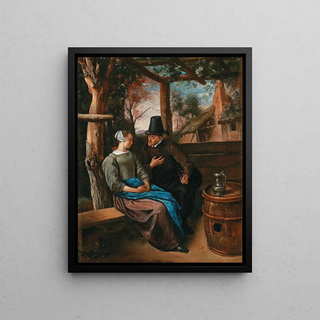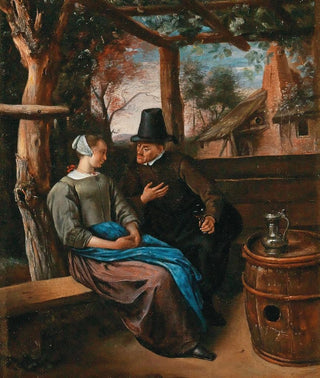Art print | A Suitor with a Young Woman - Jan Steen


View from behind

Frame (optional)
In the vibrant world of 17th-century Dutch art, Jan Steen's "A Suitor with a Young Woman" stands out for its ability to capture moments of life imbued with realism and liveliness. This painting, emblematic of the baroque style, invites viewers to immerse themselves in a universe where visual storytelling and human emotions intertwine. At the heart of this intimate scene, the curious gaze and gestures of the characters reveal social dynamics and human interactions that transcend time. The art print of this work offers a window into an era where customs and romantic relationships were both simple and complex, reflecting a society in full transformation.
Style and uniqueness of the work
Jan Steen, master of genre painting, excels in the art of visual narration. In "A Suitor with a Young Woman," the composition is carefully orchestrated, with each element having its place and meaning. The vibrant colors and meticulous details create a lively, almost tangible atmosphere. The posture of the characters, their facial expressions, and even the objects surrounding them contribute to the story told by the canvas. The suitor, with his seductive air, and the young woman, both shy and intrigued, illustrate the subtleties of romantic relationships, while the presence of an unexpected spectator adds a layer of tension and mystery to the scene. This painting, both joyful and full of innuendo, is a true invitation to reflect on human nature and its interactions.
The artist and his influence
Jan Steen, born in Leiden in 1626, is often regarded as one of the greatest painters of his time. His work is characterized by a keen sense of observation and an ability to depict everyday life with humor and irony. Steen's scenes are populated with typical characters of Dutch society, from peasants to bourgeoisie, each embodying a facet of life at the time. His influence is undeniable and has marked not only his contemporaries but also future generations of artists. By playing with social conventions and highlighting human flaws, Steen was able to give a

Matte finish

View from behind

Frame (optional)
In the vibrant world of 17th-century Dutch art, Jan Steen's "A Suitor with a Young Woman" stands out for its ability to capture moments of life imbued with realism and liveliness. This painting, emblematic of the baroque style, invites viewers to immerse themselves in a universe where visual storytelling and human emotions intertwine. At the heart of this intimate scene, the curious gaze and gestures of the characters reveal social dynamics and human interactions that transcend time. The art print of this work offers a window into an era where customs and romantic relationships were both simple and complex, reflecting a society in full transformation.
Style and uniqueness of the work
Jan Steen, master of genre painting, excels in the art of visual narration. In "A Suitor with a Young Woman," the composition is carefully orchestrated, with each element having its place and meaning. The vibrant colors and meticulous details create a lively, almost tangible atmosphere. The posture of the characters, their facial expressions, and even the objects surrounding them contribute to the story told by the canvas. The suitor, with his seductive air, and the young woman, both shy and intrigued, illustrate the subtleties of romantic relationships, while the presence of an unexpected spectator adds a layer of tension and mystery to the scene. This painting, both joyful and full of innuendo, is a true invitation to reflect on human nature and its interactions.
The artist and his influence
Jan Steen, born in Leiden in 1626, is often regarded as one of the greatest painters of his time. His work is characterized by a keen sense of observation and an ability to depict everyday life with humor and irony. Steen's scenes are populated with typical characters of Dutch society, from peasants to bourgeoisie, each embodying a facet of life at the time. His influence is undeniable and has marked not only his contemporaries but also future generations of artists. By playing with social conventions and highlighting human flaws, Steen was able to give a






